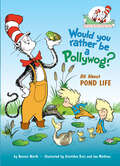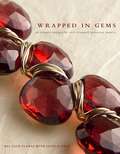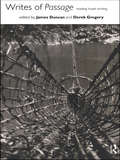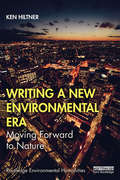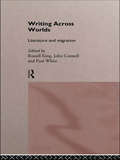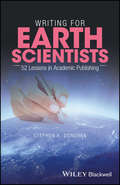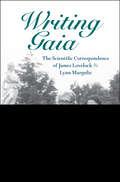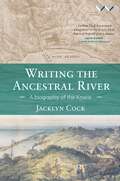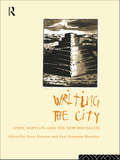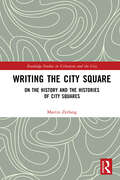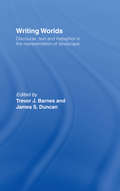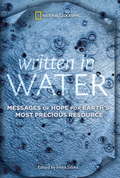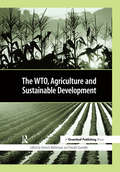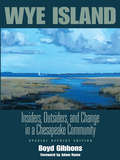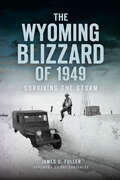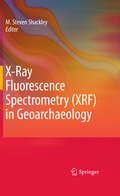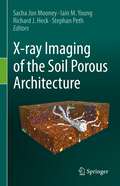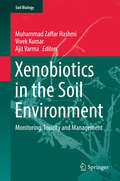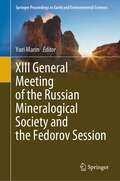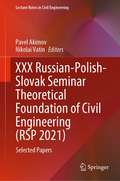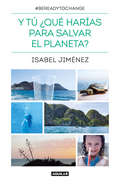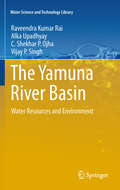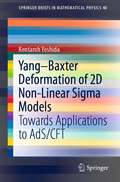- Table View
- List View
The Worth of Water: Designing Climate Resilient Rainwater Harvesting Systems
by Liam McCarton Sean O'Hogain Anna ReidThere is no more fundamental substance to life on earth than water. Three quarter of the Earth’s surface is covered by either saltwater or freshwater, yet millions face a daily struggle to access enough water for survival. The effects of ongoing climate change have expanded the water crisis to areas previously considered water secure. This book addresses the role rainwater harvesting (rwh) can play in developing a resilient water infrastructure that will prove adaptive to climate change. The book features three sections. The first section presents the concepts underpinning a new approach to water infrastructure. The term “the worth of water” was developed to reflect the importance of the social life of water. This encompasses all human relationships with water including the social, cultural, hydrological, political, economic, technical and spiritual. A technology portfolio showcasing the worth of water from the Qanats of the ancient world to the modern Rain Cities is presented. Other concepts discussed include the circular economy of water and the concept of multiple waters for multiple users of multiple qualities. Water and its properties are a function of its peculiar molecular structure and this is illustrated in the book. Rainwater harvesting is considered by the authors as containing an inherent treatment train which functions as a complex water treatment system providing physical, chemical and biological removal mechanisms. Part two presents a new design methodology together with design templates and worked examples for the hydraulic and economic analysis of rwh systems. A state-of-the-art literature review of the potential health implications of utilizing rwh is also presented. The final section of the book discusses how rwh can play a vital role in contributing to achieving the Sustainable Development Goals and to living within the Planetary Boundaries.
Would You Rather Be a Pollywog: All About Pond Life (Cat in the Hat's Learning Library)
by Bonnie WorthCats normally don't like water, but the Cat in the Hat is no normal puss! He’s fond of ponds, and in this latest Cat in the Hat’s Learning Library book, he takes Sally and Dick on a trip to show them how ponds are fascinating places teeming with life.From algae to snails, leeches, insects, fish, frogs, newts, turtles, ducks, swans, and more, the Cat explains how all different kinds of plants and animals make their home in and around ponds, as well as examining the difference between complete and incomplete metamorphosis and the various stages of frog development. Ideal for spring and summer reading, this is a beginning reader that will inspire kids to get outside and explore!
Wrapped in Gems: 40 Elegant Designs for Wire-wrapped Gemstone Jewelry
by Mai Sato-Flores Jesse FloresFew people would argue against the beauty and appeal of gemstone jewelry, but some jewelry makers find themselves intimidated by the thought of working with these precious stones. With Wrapped in Gems, even inexperienced jewelry makers can learn to fashion their own beautiful gemstone creations using Mai Sato-Flores's preferred techniques of wire wrapping and working with chain. This method allows gems to hang so that light can shine through and show off their natural beauty. For the jewelry maker, inspiration can be found anywhere, but the exquisite beauty of nature is a favorite source. Take a moment to study the leaves of a tree or plant-the contours of a leaf suggest a shape for a pendant, the perfect combination of colors in the leaves and flowers hint at a color palette of precious gemstones to mimic it. The branches and twigs, the patterns of leaf growth, even the shape of the tree or plant itself can inspire ideas for earrings, bracelets, necklaces, and rings. Wrapped in Gems shows you how to interpret all that you see in nature to create jewelry with wire, chains, and beautiful gemstones. New York City-based jewelry designer Mai Sato-Flores is inspired by nature wherever she goes-be it the supermarket, Central Park, or right outside her door. In Wrapped in Gems, she shares the secrets of her work and the natural elements that inspire it. After demonstrating how gemstones and wire can be used to recreate the patterns and designs of nature, Mai provides instructions for 40 elegant pieces of gemstone jewelry from her own collections.
Writes of Passage: Reading Travel Writing
by James Duncan Derek GregoryWrites of Passage explores the interplay between a system of "othering" which travelers bring to a place, and the "real" geographical difference they discover upon arrival. Exposing the tensions between the imaginary and real, Duncan and Gregory and a team of leading internationa contributors focus primarily upon travelers from the 18th and 19th Centuries to pin down the imaginary within the context of imperial power. The contributors focus on travel to three main regions: Africa, South Asia, and Europe - wit the European examples being drawn from Britain, France and Greece.
Writing a New Environmental Era: Moving forward to nature (Routledge Environmental Humanities)
by Ken HiltnerWriting a New Environmental Era first considers and then rejects back-to-nature thinking and its proponents like Henry David Thoreau, arguing that human beings have never lived at peace with nature. Consequently, we need to stop thinking about going back to what never was and instead work at moving forward to forge a more harmonious relationship with nature in the future. Using the rise of the automobile and climate change denial literature to explore how our current environmental era was written into existence, Ken Hiltner argues that the humanities—and not, as might be expected, the sciences—need to lead us there. In one sense, climate change is caused by a rise in atmospheric CO2 and other so-called greenhouse gases. Science can address this cause. However, approached in another way altogether, climate change is caused by a range of troubling human activities that require the release of these gases, such as our obsessions with cars, lavish houses, air travel and endless consumer goods. The natural sciences may be able to tell us how these activities are changing our climate, but not why we are engaging in them. That’s a job for the humanities and social sciences. As this book argues, we need to see anthropogenic (i.e. human-caused) climate change for what it is and address it as such: a human problem brought about by human actions. A passionate and personal exploration of why the Environmental Humanities matter and why we should be looking forward, not back to nature, this book will be essential reading for all those interested in the future and sustainability of our planet.
Writing Across Worlds: Literature and Migration
by Russell King John Connell Paul WhiteInternational migration has long been a dominant feature of world literature from both post-industrial and developing countries. The increasing demands of the global economic system and continued political instability in many of the world's region have highlighted this shifting map of the world's peoples.Yet, political concern for the larger scale economic and social impact of migration has effectively obscured the nature of the migratory nature of the migratory experience itself, the emotions and practicalities of departure, travel, arrival and the attempt to rebuild a home.Writing Across Worlds explores an extraordinary range of migration literaturesm from letters and diaries to journalistic articles, autobiographies and fiction, in order to analyse the reality of the migrant's experience. The sheer range of writings - Irish, Friulian, Italian, Jewish and South Asian British, Gastarbeiter literature from Germany, Pied noir, French-Algerian and French West Indian writing, Carribbean novels, Slovene emigrant texts, Japanese-Canadian writing, migration in American novels, narratives from Australia, South Africa, Samoa and others - illustrate the diversity of global migratory experience and emphasise the social context of literature.The geographic and literary range of Writing Across Worlds makes this collection an invaluable analysis of migration, giving voice to the hope, pain, nostalgia and triumph of lives lived in other places.
Writing for Earth Scientists: 52 Lessons in Academic Publishing
by DonovanThe time has come. You are an Earth scientist. You’ve spent weeks, months, years working on this project – now is the time to pull it together for publication. You might be writing an undergraduate or graduate thesis, a research paper for a leading journal, a note for the newsletter of the local amateur scientific society, a book review or an abstract for a specialist geological conference. How do you make the transition from promising unpublished researcher to established academic author? Of course, the phrase ‘academic publishing’ covers a multitude of sins; monographs, research papers, book reviews, conference abstracts or whatever each requires a different approach. You have to decide what it is you are going to write and where to publish it. There are co-authors, supervisors of your degree, peer reviewers and editors to deal with on the way. But the only way to write like an academic is to write like an academic. . . where do you start? You could do much worse than start here. There are many books on how to write and be published aimed at research students and other aspiring academics. Many of these are readable, comprehensive and provide good advice. This book is composed of numerous short chapters on this subject, all directly relevant to one or more aspects of academic publishing and aimed particularly at the Earth scientists in the broadest sense. Geologists will be encouraged to use the book as much as a reference as a reader, ‘dipping in’ to the chapters that contain relevant tips, hints and comments to enable them to improve the paper that they are currently writing. The book is intended to be informative, readable and, above all, of practical application for all readers. In summary, the volume will be a readable compilation investigating many facets of academic publishing relevant to the Earth sciences. It will be of particular interest to postgraduate students, postdocs and new academics
Writing Gaia: The Scientific Correspondence of James Lovelock and Lynn Margulis
by Bruce Clarke Sébastien DutreuilIn 1972, James Lovelock and Lynn Margulis began collaborating on the Gaia hypothesis. They suggested that over geological time, life on Earth has had a major role in both producing and regulating its own environment. Gaia is now an ecological and environmental worldview underpinning vital scientific and cultural debates over environmental issues. Their ideas have transformed the Earth and life sciences, as well as contemporary conceptions of nature. Their correspondence describes these crucial developments from the inside, showing how their partnership proved decisive for the development of the Gaia hypothesis. Clarke and Dutreuil provide historical background and explain the concepts and references introduced throughout the Lovelock-Margulis correspondence, while highlighting the major landmarks of their collaboration within the sequence of almost 300 letters written between 1970 and 2007. This book will be of interest to researchers in ecology, history of science, environmental history and climate change, and cultural science studies.
Writing the Ancestral River: A Biography of the Kowie
by Jacklyn CockWriting the Ancestral River is an illuminating and unusual biography of the Kowie River in the Eastern Cape. This tidal river runs through the centre of what used to be called the Zuurveld, a formative meeting ground of different peoples who have shaped our history: Khoikhoi herders, Xhosa pastoralists, Dutch trekboers and British settlers. Their direct descendants continue to live in the area and interact in ways that have been decisively shaped by their shared history. Besides being a social history, this is also a natural history of the river and its catchment area, where dinosaurs once roamed and cycads still grow. As the book shows, the natural world of the Kowie has felt the effects of human settlement, most strikingly through the establishment of a harbour at the mouth of the river in the 19th century and the development of a marina in the late 20th century. Both projects have had a decisive and deleterious impact on the Kowie. People are increasingly reconnecting with nature and justice through rivers. Acknowledging the past, and the inter-generational, racialised privileges, damages and denials it established and perpetuates, is necessary for any shared future. By focusing on this `little' river, the book raises larger questions about colonialism, capitalism, `development' and ecology, and asks us to consider the connections between social and environmental injustice.
Writing the City: Eden, Babylon and the New Jerusalem
by Peter Preston Paul Simpson-Housley`The expression of human experience it embodies ... includes all personal history'. Saul Bellow's view of the city is far from that of classic geographical descriptions which look at growth or decline, demographic patterns, traffic flows and economic potential: these empirically conceived models of urban geography fail to accommodate the crucial human aspect of city life. Located at the interface of geography and literature, Writing the City visualizes the city through the hopes, aspirations, disappointments and pains of international novelists and creative writers. From Manchester, Montreal and Sydney to Osaka, Varanasi amd Odessa, cities become more than their built environment, more than a set of class or economic relationships: they are also an experience to be lived, suffered and undergone. Thus cities are seen in terms of the innocence of an Eden now lost, a threat of sinful Babylon and the promise of a New Jerusalem.
Writing the City Square: On the History and the Histories of City Squares (Routledge Studies in Urbanism and the City)
by Martin ZerlangThe history of cities is also the history of city squares. The agora, the forum, the piazza, the plaza: All presuppose the idea of a center. It’s a material and mental phenomenon. Literature is an important part of this history, and the interplay between the square as physical space and the square as literature is the topic of this book. This is an encyclopedic book combining an overview of the history of city squares with a plethora of analytical examples of its reflection in literature: Literature uses the city square as a frame; city squares serve as frames for drama; novels and other kinds of literature comment on city squares; city squares are sources of inspiration for all sorts of literary activities. Socrates in the agora, Cicero in the Forum, Calderón in the Plaza Mayor, Corneille in the Place Royale, Richardson in Grosvenor Square, James in Washington Square, Woolf in Bloomsbury Square, Döblin and Gröschner in Alexanderplatz, Rodoreda in Diamond Square in Barcelona, DeLillo in Times Square, Al Aswany in Tahrir Square, the Maidanistas in the Maidan of Kyiv: These are just some of the examples presented and analyzed in this book. The book is of direct interest for researchers, students, and professionals such as architects and urban planners, but it is written in a way that makes it accessible for all readers with an interest in urban culture, architecture, history, literature, and cultural studies.
Writing Worlds: Discourse, Text and Metaphor in the Representation of Landscape
by Trevor J. Barnes James S. DuncanWriting Worlds represents the first systematic attempt to apply poststructuralist ideas to landscape representation. Landscape - city, countryside and wilderness - is explored through the discourse of economics, geopolitics and urban planning, travellers descriptions, propaganda maps, cartography and geometry, poetry and painting. The book aims to deconstruct geographical representation in order to explore the dynamics of power in the way we see the world.
Written in Water
by Irena SalinaWritten in Water: Messages of Hope for Earth's Most Precious Resource comprises a collection of essays authored by heroes and leaders in the field of water solutions and innovations--a broad range of people from varied disciplines who have contributed their hearts and minds to bringing awareness to and conserving Earth's freshwater supply. In their own words, authors tell of such tragedies as water slavery, drought, or contamination, as well as their own professional struggles and successes in pursuit of freshwater solutions. Contributors include: Alexandra Cousteau, social environmental advocate and granddaughter of legendary marine scientist Jacques Cousteau; Peter Gleick, environmental visionary and winner of a 2003 MacArthur "genius grant"; Bill McKibben, bestselling author and winner of a Guggenheim fellowship; Sylvia Earle, oceanographer and Time magazine's first "hero for the planet"; and Christine Todd Whitman, former head of the Environmental Protection Agency, along with more than a dozen other notable people.These visionaries' stories touch, surprise, and amaze as they help us see the essential role played by water in our world, our lives, and our future. These are all people who are thinking far beyond the realm of self; they are devoted to creating a better world for all of us.
Written in Water
by Irena SalinaWritten in Water is an unforgettable collection of the true stories of people-men and women, politicians and scientists, laymen and experts-sharing in their own words what they have seen and what they have learned in their efforts to bring clean water to all.
The WTO, Agriculture and Sustainable Development
by Heinrich Wohlmeyer Theodor QuendlerDespite the Doha declaration of November 2001, the failure to start a new round of global trade negotiations at Seattle in December 1999 and the hostility of protesters to the trade liberalization process and growing global economic and social disparities was a wake-up call for the World Trade Organisation (WTO). The ambitious goal of this ground-breaking book is to identify the strengths and weaknesses of liberalized world trade, in particular in the agricultural sector, and to investigate to what extent the current WTO agreements provide the necessary fail-safe devices to react to trade-related negative impacts on sustainability, environmental protection and food security. The background and interrelationship between the WTO, the tenets of sustainable development and the unique features of the agriculture and forestry sectors are explored, and conclusions regarding the deficits of the world trade system and its conflicts with basic societal goals – such as sustainability – are drawn. Agriculture and forestry have a particular affinity with what the authors call "strong sustainability" and are to be among the major agenda items in forthcoming WTO negotiations. The book proposes that sustainable agricultural production techniques such as integrated and organic farming provide a series of related services to community and environment which could be severely prejudiced by wholesale trade liberalization and the imposition of the large-scale production methods of the mega-trade giants of the USA and Europe. And yet the concept of sustainability is referred to only tangentially in the existing WTO agenda. The WTO, Agriculture and Sustainable Development argues that, without a formal recognition of this failing, the premise that free trade is inherently advantageous for all countries is a falsehood. Further, unfettered liberalization is unsustainable and a social and environmental multilateral framework must be agreed to reinterpret or adapt a host of WTO regulations that are at odds with sustainable development. The core problem is that, under the current system, import duties can only be differentiated by direct goods and services and not by their means of production – sustainable or otherwise. Therefore, a range of environmental policy measures in the agricultural sector, such as the consideration of product life-cycles, the internalization of external costs and a coupling of trade liberalization with ecological obligations are proposed by the authors. In addition, they argue that unsustainable economic short-termism must be curbed and the use of the stick of trade sanctions and the carrot of financial benefits for good environmental performance be permitted to promote sustainable agricultural practices. This book will contribute greatly in addressing the lack of basic theoretical arguments at the intersection between trade and sustainable development – a failing that has already been bemoaned by trade policy-makers. It is highly recommended reading for all those involved or interested in the WTO negotiations, whether from multilateral organizations, governments, industry or civil society.
Wye Island: Insiders, Outsiders, and Change in a Chesapeake Community - Special Reprint Edition
by Boyd GibbonsToday, most of the 2,800 tranquil acres that make up Wye Island are managed by the Maryland Park Service. However, from 1973 to 1974, the island was the site of a raging controversy. A major developer, James Rouse, wanted to build a compact waterfront village that would be surrounded by large estates, protected farms, and wetlands. A boyhood resident of nearby Easton, Maryland, Rouse hoped that the island could avoid the sprawl of unplanned subdivisions that were marring so many other places along the Eastern Shore. Combining history, journalism, character sketches, and sharp sociological insight, Boyd Gibbons presents the conflict over Wye Island in its multiple dimensions - as an example of the emerging community-based activism of the 1960s and 70s, and of a community that, while exercising its right to preserve its identity, denies opportunities for its members to improve their lives through change. In fact, Wye Island proves not to be the environmental David-Goliath struggle that might be expected. For one thing, residents opposed a development plan that can be regarded as an early model for 'smart growth.' And many were no more favorably disposed to a park or preserve than to a planned village. Their interest was in protecting the community from an invasion of immigrants from ethnically diverse Baltimore and Washington, and, where the wealthy were concerned, protecting some very private views of the water. In the end, rich landowners, poor 'natives,' and many recent newcomers opposed the Rouse project - distrusting change, and, above all, fearing 'outsiders.' The special reprint of Wye Island includes a new foreword by distinguished environmental historian Adam Rome, who explores the enduring themes of Wye Island in context of the current debates about land use, development, and sprawl.
The Wyoming Blizzard of 1949: Surviving the Storm (Disaster)
by James C FullerA Wyoming historian shares an in-depth look at the historic storm and its devastating aftermath through the stories of those who survived. The Blizzard of 1949 took Wyoming and neighboring states by surprise. In January of that year, snow, wind and frigid temperatures devastated the northern plains. The storm stranded hundreds of motorists on the highways and stalled nearly two dozen trains at depots throughout the state. For nearly two months, towns and ranches were marooned by enormous drifts, some reportedly eighty feet tall. Communities pulled together to assist not only their neighbors but also anyone unable to escape the snowstorm. Drawing on meticulous research and numerous in-person interviews, author and historian James Fuller recounts these harrowing stories of tenacity and fortitude.
X-Ray Fluorescence Spectrometry (XRF) in Geoarchaeology
by M. Steven ShackleySince the 1960s, x-ray fluorescence spectrometry (XRF), both wavelength and energy-dispersive have served as the workhorse for non-destructive and destructive analyses of archaeological materials. Recently eclipsed by other instrumentation such as LA-ICP-MS, XRF remains the mainstay of non-destructive chemical analyses in archaeology, particularly for volcanic rocks, and most particularly for obsidian. In a world where heritage and repatriation issues drive archaeological method and theory, XRF remains an important tool for understanding the human past, and will remain so for decades to come. Currently, there is no comprehensive book in XRF applications in archaeology at a time when the applications of portable XRF and desktop XRF instrumentation are exploding particularly in anthropology and archaeology departments worldwide. The contributors to this volume are the experts in the field, and most are at the forefront of the newest applications of XRF to archaeological problems. It covers all relevant aspects of the field for those using the newest XRF technologies to deal with very current issues in archaeology.
X-ray Imaging of the Soil Porous Architecture
by Sacha Jon Mooney Iain M. Young Richard J. Heck Stephan PethThe advent of X-ray Computed Tomography (CT) as a tool for the soil sciences almost 40 years ago has revolutionised the field. Soil is the fragile, thin layer of material that exists above earth’s geological substrates upon which so much of life on earth depends. However a major limitation to our understanding of how soils behave and function is due to its complex, opaque structure that hinders our ability to assess its porous architecture without disturbance. X-ray imagery has facilitated the ability to truly observe soil as it exists in three dimensions and across contrasting spatial and temporal scales in the field in an undisturbed fashion. This book gives a comprehensive overview of the “state of the art” in a variety of application areas where this type of imaging is used, including soil water physics and hydrology, agronomic management of soils, and soil-plant-microbe interactions. It provides the necessary details for entry level readers in the crucial areas of sample preparation, scanner optimisation and image processing and analysis. Drawing on experts across the globe, from both academia and industry, the book covers the necessary “dos and don’ts”, but also offers insights into the future of both technology and science. The wider application of the book is provided by dedicated chapters on how the data from such imagery can be incorporated into models and how the technology can be interfaced with other relevant technical applications. The book ends with a future outlook from the four editors, each of whom has over 20 years of experience in the application of X-ray CT to soil science.
Xenobiotics in the Soil Environment
by Muhammad Zaffar Hashmi Vivek Kumar Ajit VarmaThis book describes the vast variety of xenobiotics, such as pesticides, antibiotics, antibiotic resistance genes, agrochemicals and other pollutants, their interactions with the soil environment, and the currently available strategies and techniques for soil decontamination and bioremediation. Topics covered include: transport mechanisms of pollutants along the Himalayas; use of earthworms in biomonitoring; metagenomic strategies for assessing contaminated sites; xenobiotics in the food chain; phyto-chemical remediation; biodegradation by fungi; and the use of enzymes and potential microbes in biotransformation. Accordingly, the book offers a valuable guide for scientists in the fields of environmental ecology, soil and food sciences, agriculture, and applied microbiology.
XIII General Meeting of the Russian Mineralogical Society and the Fedorov Session (Springer Proceedings in Earth and Environmental Sciences)
by Yuri MarinThis book presents the materials of the XIII General Meeting of the Russian Mineralogical Society. Over 190 participants prepared the result of their scientific work on mineralogy: mineral diversity and the evolution of mineral formation (S1); minerals as markers of petro- and ore genesis and new methods of their determination (S2); mineralogy and formation conditions of deposits of strategic minerals (S3); problems of applied (technological and ecological) mineralogy and geochemistry (S4); natural stone in art and architecture (S5); modern research in the field of stone and gemological studies (S6); mineralogical crystallography, crystallochemistry, and new minerals (F1); history of science, museumification, and popularization of natural science knowledge (F2). The Russian Mineralogical Society is the oldest mineralogical Society in Russia (from 1817). The Russian Mineralogical Society joins more than 1200 researchers from universities, academic and industry institutes, and production organizations in Russia's major scientific centers. The Society has 17 sections, including crystallochemistry, radiography and spectroscopy of minerals, ore mineralogy, technological mineralogy, experimental mineralogy, ecological mineralogy and geochemistry, and new mineral nomenclature classification. The main scientific and organizing event for the Russian Mineralogical members is the meeting session, organized every fourth year.
XXX Russian-Polish-Slovak Seminar Theoretical Foundation of Civil Engineering: Selected Papers (Lecture Notes in Civil Engineering #189)
by Pavel Akimov Nikolai VatinThis book gathers the latest advances, innovations, and applications in the field of civil, environmental and construction engineering, as presented by researchers and engineers at the XXX Annual Russian-Polish-Slovak Seminar Theoretical Foundation of Civil Engineering (RSP), held in September 2021. Co-organized by six universities from Russia, Poland and Slovakia, the event covered diverse topics such as structural mechanics; building structures; geodesy and geotechnics; transport and environmental issues in civil engineering. The contributions, which were selected by means of a rigorous international peer-review process, highlight numerous exciting ideas that will spur novel research directions and foster multidisciplinary collaborations.
Y tú ¿qué harías para salvar el planeta?
by Isabel JiménezUn ensayo periodístico comprometido y valiente que aporta alternativas y soluciones a la contaminación producidad por el plástico. «No se trata de volver al pasado, se trata de buscar un futuro en el que tenga cabida el progreso, pero con soluciones sostenibles a los residuos. Apostemos por el consumo responsable», escribe Isabel Jiménez en Y tú ¿qué harías para salvar el planeta? Uno de los rostros más respetados de la televisión muestra su compromiso con la sostenibilidad y el medioambiente en un tema que exige soluciones ya: la reducción del consumo de plástico. El futuro del planeta está en nuestras manos, y la solución al problema también. Hay esperanza: todavía estamos a tiempo para cambiar el futuro. Es posible un consumo responsable que permita una reducción drástica de los plásticos de un solo uso. Se puede caminar hacia un nuevo modelo de producción más acorde con la naturaleza. Es hora de apostar por la economía circular: «Hacer más con menos, reducir la materia prima y reutilizar». Y el compromiso es de todos: de los gobiernos, de los empresarios, de los activistas públicos, de los ciudadanos y del propio sector del plástico. En palabras de la autora: «A todos nos debería importar qué está pasando en los mares, en los ríos y en los océanos». Convirtámonos en la generación del cambio, salvemos el planeta. Y tú ¿qué harías para salvar el planeta? es un nuevo reto en la carrera profesional de la periodista Isabel Jiménez. En sus páginas muestra su compromiso con el medioambiente y deja el sello de su estilo: rigor informativo y cercanía para convertir en realidad un objetivo necesario.
The Yamuna River Basin
by Alka Upadhyay C. Shekhar Ojha Raveendra Kumar Rai Vijay P. SinghThis book is designed to provide concepts, methodologies, and approaches for river basin studies with respect to water resources and environment. The book is not limited to the Yamuna River basin, but will help in the study of various other river basins for integrated water resources management. The book covers the essential components of integrated water resources management, including analysis of climatic variables, climate change detection, analysis of natural resources, geology, geomorphology, socio-economics, water budgeting, flood estimation, river pollution, etc. Furthermore, the book addresses recent issues pertaining to water quality, water quality indices, environmental flows, water resources management through cropping pattern change, etc. along with methodologies and application to the Yamuna River system. However, the main objective of this book is to address important issues of water resources management of river basins. Audience: The manuscript has been designed so that it can be used as a reference for river basin studies. The book will be useful to engineers, agricultural scientists, environmentalists, planners, managers, and administrators who are concerned with water resources.
Yang–Baxter Deformation of 2D Non-Linear Sigma Models: Towards Applications to AdS/CFT (SpringerBriefs in Mathematical Physics #40)
by Kentaroh YoshidaIn mathematical physics, one of the fascinating issues is the study of integrable systems. In particular, non-perturbative techniques that have been developed have triggered significant insight for real physics. There are basically two notions of integrability: classical integrability and quantum integrability. In this book, the focus is on the former, classical integrability. When the system has a finite number of degrees of freedom, it has been well captured by the Arnold–Liouville theorem. However, when the number of degrees of freedom is infinite, as in classical field theories, the integrable structure is enriched profoundly. In fact, the study of classically integrable field theories has a long history and various kinds of techniques, including the classical inverse scattering method, which have been developed so far. In previously published books, these techniques have been collected and well described and are easy to find in traditional, standard textbooks. One of the intriguing subjects in classically integrable systems is the investigation of deformations preserving integrability. Usually, it is not considered systematic to perform such a deformation, and one must study systems case by case and show the integrability of the deformed systems by constructing the associated Lax pair or action-angle variables. Recently, a new, systematic method to perform integrable deformations of 2D non-linear sigma models was developed. It was invented by C. Klimcik in 2002, and the integrability of the deformed sigma models was shown in 2008. The original work was done for 2D principal chiral models, but it has been generalized in various directions nowadays. In this book, the recent progress on this Yang–Baxter deformation is described in a pedagogical manner, including some simple examples. Applications of Yang–Baxter deformation to string theory are also described briefly.

